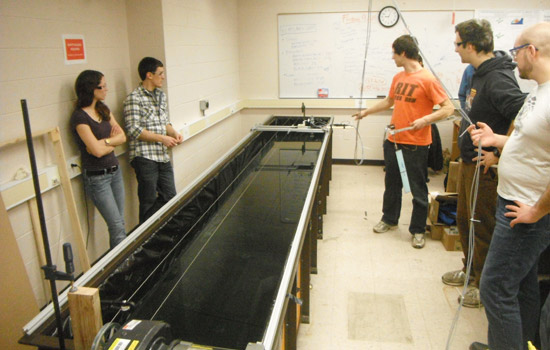Project to develop alternative energy from rivers recognized at EPA Expo
RIT students’ alternative energy hydrofoil project receives honorable mention
Provided by Mario Gomes
Engineering students built a 16-foot tow tank as part of a low-impact hydropower generator project. They will compete against other collegiate teams in an upcoming Environmental Protection Agency competition and showcase their project during the Imagine RIT Innovation and Creativity Festival on May 5.
Hoover Dam spans the Colorado River. Robert Moses – Niagara Power Plant is adjacent to the Niagara River. Three Gorges Dam bridges the Yangzte River.
Building hydroelectric plants on rivers has long been a means to provide needed renewable energy to communities around the globe. Yet the impact to the local environment varies and in some instances significantly alters ecosystems.
What if there is a way to still harness the power of a river and limit the environmental impact of building immense dams and hydroelectric plants? A project by undergraduate students at RIT could provide an alternative to address this question.
In the project “Scalable, Low-Impact, Run-of-River Hydropower Generator,” students in the Kate Gleason College of Engineering designed a hydrofoil system that harvests energy from a river while minimizing the harmful effects that dams create for river flow and sediments. Hydrofoils are similar in shape to airplane wings or rotors that when turned produce kinetic energy. Attached to power generation systems, the energy is harvested and converted for use.
The RIT project was selected as a Phase I finalist for the 2012 Environmental Protection Agency People, Prosperity and the Planet Conference and Expo and received an honorable mention designation at the event that took place April 21-24 on the National Mall in Washington, D.C.
The RIT student-team was among 45 universities competing in Phase II at the expo showcasing solutions that address environmental challenges. They provided data about the power that could potentially be generated by the hydrofoil design and the impact on the water system due to its operation.
Building and Testing the Model
The RIT project is a scaled-down version of a hydropower system, says Mario Gomes, professor of mechanical engineering and project manager. The students designed, built and tested a model hydrofoil in the Genesee River near the RIT campus as well as in a 16-foot tow-tank they built in Gomes’ Energy and Motion Lab.
“We moved the river into the lab,” says Gomes about the indoor testing process.
As part of the research, the students had to assess both the positive and possible negative effects of the system. Additionally, they measured the torque on the generator and the generator shaft speed to determine the power produced, and found the small-scale indoor system could produce a cycle average of 2.5 watts.
“These runs were not designed to maximize power but to validate the model,” says Gomes, who added that the power scale of a system like the one the students built compared to today’s hydroelectric plants are vastly different. “There’s only so much power we can get from this at this point; our predictions are low. Theoretically, when the flow rates get higher, we should be able to get more power out, but again, we want to verify that we are right.”
The EPA competition has two phases where interdisciplinary student teams compete for $15,000 grants to further the designs with the potential to implement the projects commercially. The RIT team was awarded an initial grant in the fall and worked over two-plus quarters on the design and development of the hydrofoil system.
Note: Members of the hydrofoil design team are Geoff Bastian, Chris Donnelly, Joe Fertitta, Justin Grates, Donald Leclerc, Matt Marion, Hope Alm, Tim Buckner, Will Lentlie, Andres Santizo Matheu, Shauna Traxler Adam Dunn, Andrew Garland, Vulf Kirman, Mark Negro and Michelle Wang. Harshita Sood, a student in RIT’s environmental science program, also worked with the team to define potential methods for assessing impacts of the system on the current river ecosystem as well as possible fish reintroduction programs that may occur in the Genesee River.






